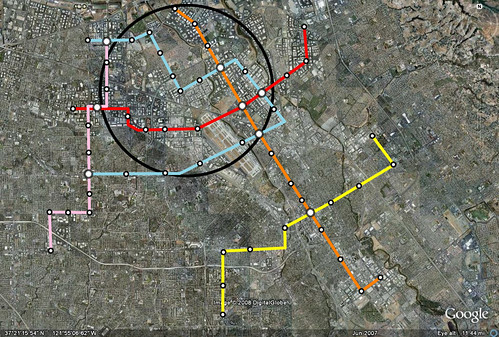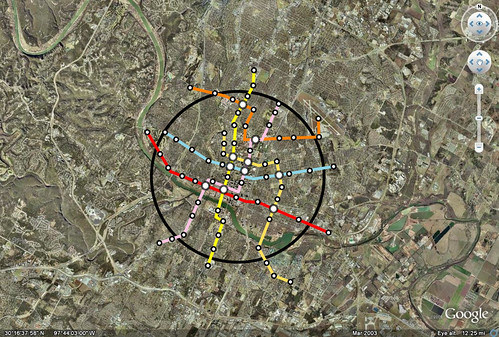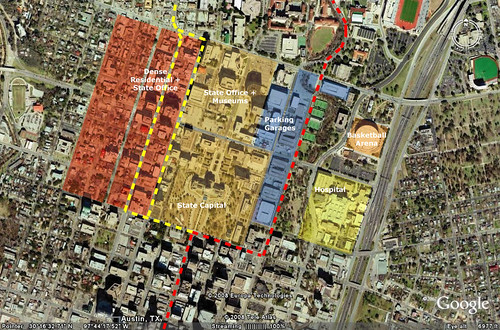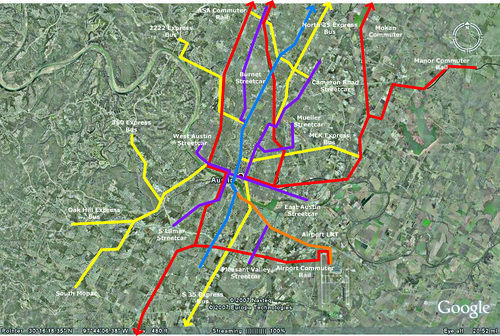Thursday, January 29, 2009
Information Underload 101
As you all know, I'm not a reporter. But if I were to write a column on transportation, I would probably educate myself about what the best practices are around the country and fill my feed reader with every single piece of transportation information I can to inform my writing. I try to do that anyway but I don't get paid to write and I don't have a whole city to inform. But newspapers wonder why they are losing readers and market share to other sources and I would say its because the information they give is just too basic, especially on issues such as transportation.
While blog commentary will never take the place of reporting, they are creating an elevated discussion about niche issues such as transit and development. As I was discussing with a colleague the other day, if we were relating blogs to college courses, newspapers are often the intro courses and blogs the upper level electives. Feel free to look at the course schedule.
Update 1.30.09: David has more on newspaper issues including simple things they can do like linking out.
Monday, January 5, 2009
Round Rock Rail?
Thursday, January 1, 2009
Things We Could Have Told You
However, very few road projects are 100 percent “toll viable” — meaning, profitable and thus enticing to the private sector...So much for PPPs for all!
Tuesday, December 23, 2008
Anti-Rail Activist Out of Office
Tuesday, December 16, 2008
Remember the Alamo
The shocker last night wasn't so much that a local toll-road official will take over as chairman of VIA Metropolitan Transit.This might be the first shot in a long Texas war that would attempt to combine these recently created mobility authorities with local transit agencies. Not something that is unfamiliar so close to the Alamo. My fear is a region wide transportation authority focused on toll roads will give suburban jurisdictions too much clout over all transportation and leave the more urban areas hanging out to dry. Specifically, Austin's outside pols have been trying to take away Capital Metro's sales tax for as long as anyone can remember. We'll have to watch and see what happens, but color me skeptical.It had more to do with a revelation that behind-the-scene talks have drifted toward the possibility of merging the toll and bus agencies into a super agency. The Alamo Regional Mobility Authority, which is banking on toll-road plans but can pretty much do any type of transportation project, recently outlined an idea to create an overarching Multi-Modal Transportation Finance System.
With it, VIA and the RMA would combine to maximize financing capacity while allowing each agency to operate independently, says the RMA document, which was prepared for a city-county transportation task force.
Sunday, December 14, 2008
Stadler Doesn't Look So Bad Now
Thursday, December 11, 2008
Find Out What You're Asking For
For San Francisco, here's the link. Definitely needed things including a new control room and midlife overhauls for buses and the Bredas. I wonder if they have pong on their current control room computers.
And the city that sees this as an opportunity to do big things, Salt Lake City. Asking $403 million for five different light rail projects.
Another quirky thing, Austin asks for $80 million to update the current commuter rail line ($220 in rail asks). Does this mean electrification? Double tracking? Is that possible? What does urban rail vehicle purchases mean. Soooo confused!
If you find something interesting, let us know in the comments.
Monday, November 3, 2008
Waiting for Guffman or TOD
But the opportunity lost for smart redevelopment on Guadalupe and other streets was huge. My most hated project was the one on the corner of 38th and Guadalupe, a stupid Starbucks built by notorious rail hater John Lewis. What a waste of an acre. Instead of ground floor retail and 20+ housing units, they got a Texadelphia and a Starbucks in a single story building. That development was a direct result of the 2000 light rail loss.
Now in the current instance, the developer pausing is ok, but its likely the project as a whole won't be transit oriented like it should be. It's not like they need permission to build a dense transit oriented development on Riverside. There are University of Texas buses as well as Capital Metro buses that run there. At some point in the future their should be higher capacity transit. The last thing that irks me is that they are waiting for the city instead of being more proactive in pushing for the rail line. If they realized the value it would create for thier property they should be the ones pushing on the city, not the other way around. And it would benefit them to wait a bit for the market to get better as well. Apologies to my friends who are transit oriented developers, but your colleagues need an education.
Thursday, October 23, 2008
Is the TTC Really Dead?
"I want to clear this up. I did not vote for the Trans-Texas Corridor and you're welcome to look at the voting records," he said in a broadcast by KXAN in Austin. Then Craddick, a Republican who was debating his Democratic opponent, Bill Dingus, in Midland, stuck a fork in the Trans-Texas Corridor and declared the ambitious plan done, according to KXAN. "Everybody in Austin knows it's dead," he said. "Everybody across the state knows it's dead. It's just something to be talking about."
Wednesday, October 1, 2008
Commuter Rail Delays
Thursday, August 14, 2008
A Tale of Two Cities
The agency has bumped along at times, and it occasionally looked as if the wheels could come off. Overall, though, DART's foresight yielded achievements other regions envy.
Chief among them is an expanding rail transit network that now stretches over 45 miles in four directions, through Dallas and into three suburbs. The mileage will double in the next five years, reaching Fair Park next year and Carrollton, Farmers Branch and the Pleasant Grove area by the end of 2010. Service to Irving, Rowlett and D/FW Airport will follow.
It's one of the nation's most ambitious transit expansions, one that will pay social and economic dividends for decades.
Saturday, August 9, 2008
The Option of Urbanism: Subsidizing the Rich
According to Myron Orfield's Metropolitics, the affluent outer-ring suburbs in the favored quarter "dominate regional economic growth and garner a disproportionate share of the region's new roads and other development infrastructure." Orfield also pointed out that much of the funding for this infrastructure is raised from the region as a whole. For example, all car-driving residents in the region pay gas taxes to partially support the building of highways, and taxpayers of the region as a whole pay the rest of the money through their income, property, and sales taxes.So this happens for roads, but people yell and scream bloody murder when they are taxed for transit and "it doesn't help me directly". The worst part about this as well is that cities are slowly signing on to their own declines.
The unlikely consequence of this pattern of infrastructure development is that the whole region pays for infrastructure that tends to be placed in the favored quarter; the poor pay for the infrastructure of the rich. According to Orfield, the central cities of Minneapolis and St. Paul, for example, pay $6 million a year to help move their middle class households and businesses to the edge of the region.Part of the problem is the regional competition for jobs. Minneapolis has a tax base sharing program that might alleviate this a little, but most regions are not so lucky. And there is still exporting going on to places like Bloomington and Eden Prairie.
M1ek has discussed this before and James Rowen covered a similar issue for Milwaukee in talking about how much they give to the regional planning commission, and how little they get out of it. Perhaps this is something that needs to be put in mayor's and city council members faces. DC, for all its flaws has the right idea of trying to take care of its citizens instead of the folks who take advantage of their services during the day, but drive back out at night.
Tuesday, August 5, 2008
Option of Urbanism: Favored Quarter
These housing and retail trends began to reveal a new and unexpected metropolitan development trend. Each metro area began to grow in a single predominant direction: the favored quarter, a ninety degree arc that starts in the traditional downtown of the major city in the region and fans outward in one direction.Very interesting concept that I had never heard of before. Some examples would include northwest Austin and East Seattle towards Redmond. He mentions that 70% of Seattle's office space is in this quarter. Some cities such as San Francisco and New York have multiple favored quarters because they are such large regions.
...
The unlikely consequence of this pattern of infrastructure development is that the whole region pays for infrastructure that tends to be placed in the favored quarter; the poor pay the infrastructure of the rich.
Tuesday, July 29, 2008
Statesman Road Block

Sunday, July 6, 2008
Been Thinking About Transit Density Part 2
For San Francisco, Eric and others have looked at what a city wide metro would look like. However I thought it would be good to look at it from the standpoint of the sphere I created for the Oakland Map. These aerials are the same dimensions as the Oakland map as are the 5 mile spheres. In the fine grid of San Francisco, you can see that a metro as envisioned below would create a tic tac toe board where getting from destinations all over the densest parts of the city would be fairly easy.

For San Jose though I took a different approach. Instead of using downtown as the center, like Oakland, I thought about how a metro could be used to reconfigure the city and employment districts of Silicon Valley. What came out of it was a more northern sphere centered around west of the airport where there is a lot of land and buildings that could be rebuilt now that their 20-30 year life might be almost over.
It was hard to not try and cover everything instead of focusing on the sphere. These city sphere metro projects could be pretty inexpensive when compared to their resulting benefit which is why its important to think about the area in much smaller terms and corridors.

In San Jose in particular, it grew up in such a spread out pattern, that serving the area, unlike Oakland and San Francisco, would be even more daunting. But its possible to use this metro as a starting point to comprehensive feeder bus and commuter rail system that connects the major cities.
Below is an example of this exercise at build out in Austin at the same scale.

So the point of this exercise isn't to say that these networks should be built with these specific lines, but to show transit density in a core area that would promote the usage of transit in the core while also starting to change the development paradigm. If this type of service were available, walkable neighborhoods would be constructed that have more opportunities to go carless. These networks could also be used as a basis for bike planning.
Thursday, May 22, 2008
Two Peas in a University Pod
Here is the U of M alternate route from the Pioneer Press.

Now here are the alternate Austin routes I drew up where the yellow is the better route, however the University continues to push the red route.

I believe what this shows is that Universities for one are scared of things they don't understand, and that they know nothing about transportation planning and so are trying to solve a problem that only exists 8 times a year. Football game and special event congestion. With Austin, they're running the line right past the performing arts center, the football stadium and the track and swim stadiums instead of by the main campus and the dense residential neighborhood to the west.
Another perceived problem is that light rail is dangerous to pedestrians. Unlike those extremely safe cars careening through and around campus driven by students. But it just goes to show that Universities shouldn't control regional decisions by throwing fits. If there were a real issue, regional planners would understand and back off, but planning so that cars can keep driving through campus and less trips on transit can be taken is unacceptable.
Tuesday, May 20, 2008
Gas Tax Losers
A few examples: for every gas tax dollar to the feds
Austin gets 76 cents
SF gets $1.44
LA gets 87 cents
Columbus OH 66 cents
It seems like if you have a transit system, you get real money back.
Thursday, May 8, 2008
Austin Hits the Pause Button
Thursday, March 6, 2008
Why the Line MUST Go Up Guadalupe Street
It's been stated before that Krusee plans to use the streetcar as a redevelopment tool to turn over some of the parking garages at the State into redevelopment opportunities. I'm all for redevelopment and streetcars as I've said before, but if this line gets built, they're risking possible expansion and political will by not building where people really want to go. There is one route that is a home run that will guaranty expansion...Guadalupe.
Here are 4 reasons why Austin needs to start light rail with the best starter light rail line possible
1. 1994 Denver - Built a very successful starter line and used that success to go after a 119 mile expansion plan
2. 1999 Salt Lake City - Opened North South Line connecting major destinations blowing out ridership projections. Recently passed a sales tax to build 5 new lines.
3. 2004 Houston - Built a starter line through the center of the two largest job centers in the city. Ridership is highest per mile of any new LRT line in the United States. 5 new lines are being planned and 2 are expected to be funded by the FTA later this year.
4. 2004 Minneapolis - Built Hiawatha line which exceeded 2025 projections. 30,000 riders and the DFL party just forwarded a bill that will give the region 8 corridors by 2020.
Let's take a look at how to do this in Austin because you don't often get a second chance.
Through the Capital Complex

The red line is the "preferred alignment" by Capital Metro and the political backroom dealers. As you can see, the blue are parking garages and the red is existing dense development that is served by the most used bus corridor in the City (#1). Which one makes more sense? Go where the people are? or go where the cars are housed?
Through the University

UT is one of the largest Universities in the country. There is a large concentration of students going to classes every day in the area I've labeled main university where the Guadalupe alignment should go. On the left side of the Guadalupe alignment, the West Campus area where the highest concentration of students live has just been rezoned for high density mixed use. Think the Pearl District and South Lake Union. The Back Room alignment goes by all of the facilities that people use perhaps 8-10 times a year. The swimming pool, the track, the stadium, the LBJ Library and the Bass Concert Hall. The problem is, people don't go there often from Downtown or from up North. The area east of the red alignment is generally dead space...I spent most of my time at UT running around that track and just outside its walls. Not too many people there.
Next we'll talk about the more northern options but lets do the first section right this time.
Wednesday, February 27, 2008
Austin Article Update


